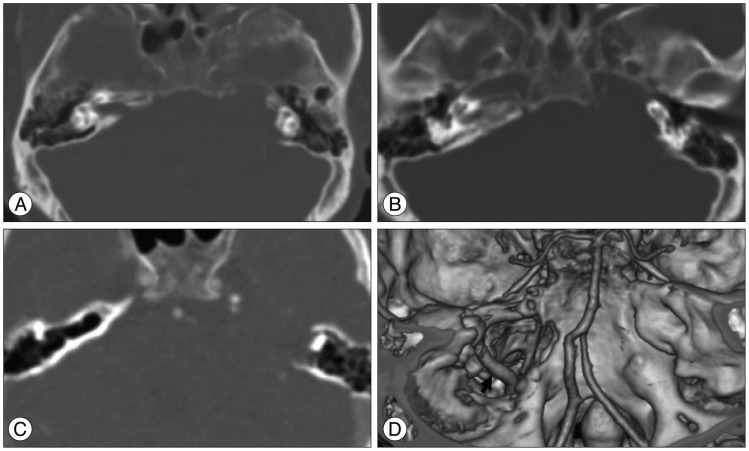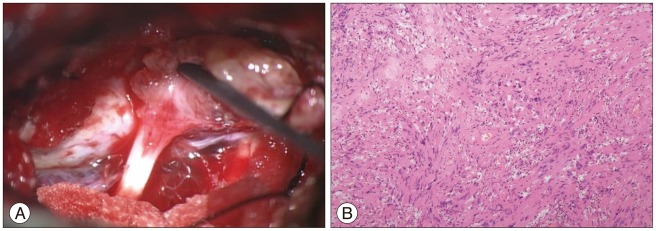J Korean Neurosurg Soc.
2015 Apr;57(4):292-294. 10.3340/jkns.2015.57.4.292.
Vestibular Schwannoma Atypically Invading Temporal Bone
- Affiliations
-
- 1Department of Neurosurgery, School of Medicine, Ewha Womans University, Seoul, Korea. drekseo@ewha.ac.kr
- KMID: 1956429
- DOI: http://doi.org/10.3340/jkns.2015.57.4.292
Abstract
- Vestibular schwannoma (VS) usually present the widening of internal auditory canal (IAC), and these bony changes are typically limited to IAC, not extend to temporal bone. Temporal bone invasion by VS is extremely rare. We report 51-year-old man who revealed temporal bone destruction beyond IAC by unilateral VS. The bony destruction extended anteriorly to the carotid canal and inferiorly to the jugular foramen. On histopathologic examination, the tumor showed typical benign schwannoma and did not show any unusual vascularity or malignant feature. Facial nerve was severely compressed and distorted by tumor, which unevenly eroded temporal bone in surgical field. Vestibular schwannoma with atypical invasion of temporal bone can be successfully treated with combined translabyrinthine and lateral suboccipiral approach without facial nerve dysfunction. Early detection and careful dissection of facial nerve with intraoperative monitoring should be considered during operation due to severe adhesion and distortion of facial nerve by tumor and eroded temporal bone.
MeSH Terms
Figure
Reference
-
1. Briggs RJ, Fabinyi G, Kaye AH. Current management of acoustic neuromas : review of surgical approaches and outcomes. J Clin Neurosci. 2000; 7:521–526. PMID: 11029233.
Article2. Feghali JG, Kantrowitz AB. Atypical invasion of the temporal bone in vestibular schwannoma. Skull Base Surg. 1995; 5:33–36. PMID: 17171155.
Article3. Lipkin AF, Coker NJ, Jenkins HA, Alford BR. Intracranial and intratemporal facial neuroma. Otolaryngol Head Neck Surg. 1987; 96:71–79. PMID: 3118299.
Article4. Lo WWM. Tumors of the temporal bone and cerebellopontine angle. In : Som PM, Bergeron RT, editors. Head and Neck Imaging. ed 2. St. Louis: Mosby;1991. p. 420–445.5. Takada Y, Ohno K, Hirakawa K.[Morphological and clinical study of acoustic tumor with respect to enlargement of internal auditory canal : mechanism of bone destruction]. No Shinkei Geka. 1996; 24:739–742. PMID: 8741409.6. Varughese JK, Breivik CN, Wentzel-Larsen T, Lund-Johansen M. Growth of untreated vestibular schwannoma : a prospective study. J Neurosurg. 2012; 116:706–712. PMID: 22264178.
- Full Text Links
- Actions
-
Cited
- CITED
-
- Close
- Share
- Similar articles
-
- Hypervascular Vestibular Schwannoma: A Case Report
- Diagnosis and Management of Vestibular Schwannoma: Focus on Dizziness
- Vestibular Histopathology in Temporal Bone
- Primary Rhabdomyosarcoma in Temporal Bone Invading Petrous Bone
- Tumor Growth and Hearing Changes in the Natural Progress of Vestibular Schwannoma




